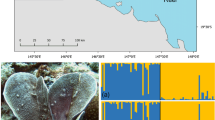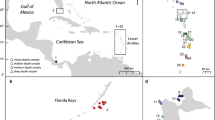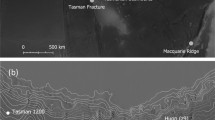Abstract
Pelagic dispersal of larvae in sessile marine invertebrates could in principle lead to a homogeneous gene pool over vast distances, yet there is increasing evidence of surprisingly high levels of genetic differentiation on small spatial scale. To evaluate whether larval dispersal is spatially limited and correlated with distance, we conducted a study on the widely distributed, viviparous reef coral Seriatopora hystrix from the Red Sea where we investigated ten populations separated between ~0.150 km and ~610 km. We addressed these questions with newly developed, highly variable microsatellite markers. We detected moderate genetic differentiation among populations based on both F ST and R ST (0.089 vs. 0.136, respectively) as well as considerable heterozygote deficits. Mantel tests revealed isolation by distance effects on a small geographic scale (≤20 km), indicating limited dispersal of larvae. Our data did not reveal any evidence against strictly sexual reproduction among the studied populations.




Similar content being viewed by others
References
Adjeroud M, Tsuchiya M (1999) Genetic variation and clonal structure in the scleractinian coral Pocillopora damicornis in the Ryukyu Archipelago, southern Japan. Mar Biol 134:753–760
Anderson TJC, Su XZ, Roddam A, Day KP (2000) Complex mutations in a high proportion of microsatellite loci from the protozoan parasite Plasmodium falciparum. Mol Ecol 9:1599–1608
Atoda K (1951) The larva and postlarval development of the reef-building corals. V. Seriatopora hystrix Dana. The Science Reports of the Tohoku University, Series 4:33–39
Ayre DJ (1984) The effects of sexual and asexual reproduction on geographic variation in the sea anemone Actinia tenebrosa. Oecologia 69:222–229
Ayre DJ, Dufty S (1994) Evidence for restricted gene flow in the viviparous coral Seriatopora hystrix on Australia‘s Great Barrier Reef. Evolution 48:1183–1201
Ayre DJ, Resing JM (1986) Sexual and asexual production of planulae in reef corals. Mar Biol 90:187–190
Ayre DJ, Davis AR, Billingham M, Llorens T, Styan C (1997a) Genetic evidence for contrasting patterns of dispersal in solitary and colonial ascidians. Mar Biol (Berl) 130:51–61
Ayre DJ, Hughes, TP, Standish, RJ (1997b) Genetic differentiation, reproductive mode, and gene flow in the brooding coral Pocillopora damicornis along the Great Barrier Reef, Australia. Mar Ecol Prog Ser 159:175–187
Ayre DJ, Hughes, TP (2000) Genotypic diversity and gene flow in brooding and spawning corals along the Great Barrier Reef, Australia. Evolution 54:1590–1605
Balloux F, Goudet J (2002) Statistical properties of population differentiation estimators under stepwise mutation in a finite island model. Mol Ecol 11:771–783
Balloux F, Lugon-Moulin N (2002) The estimation of population differentiation with microsatellite markers. Mol Ecol 11:155–165
Bastidas C, Benzie JAH, Fabricius KE (2002) Genetic differentiation among populations of the brooding soft coral Clavularia koellikeri on the Great Barrier Reef. Coral Reefs 21:233–241
Ben-Shlomo R, Douek J, Rinkevich B (2001) Heterozygote deficiency and chimerism in remote populations of a colonial ascidian from New Zealand. Mar Ecol Prog Ser 209:109–117
Bohonak AJ (2002) IBD (Isolation by distance): a program for population genetic analyses of isolation by distance. Available from http://www.bio.sdsu.edu/pub/andy/IBD.html
Brazeau DA, Harvell CD (1994) Genetic structure of local populations and divergence between growth form in a clonal invertebrate, the Caribbean octocoral Briareum asbestinum. Mar Biol 119:53–60
Brookfield JFY (1996) A simple new method for estimating null allele frequency from heterozygote deficiency. Mol Ecol 5:453–455
Callen DF, Thompson, AD, Shen Y, Phillips HA, Richards RI, Mulley JC, Sutherland GR (1993) Incidence and origin of “null” alleles in the (AC)n microsatellite markers. Am J Hum Gen 52:922–927
Chakraborty R, de Andrade M, Daiger SP, Budowle B (1992) Apparent heterozygote deficiencies observed in DNA typing data and their implications in forensic applications. Ann Hum Gen 56:45–57
Crozier RH, Kaufmann B, Carew ME, Crozier YC (1999) Mutability of microsatellites developed for the ant Camponotus consobrinus. Mol Ecol 8:271–276
Dai CF, Fan TY, Yu JK (2000) Reproductive isolation and genetic differentiation of a scleractinian coral, Mycedium elephantosus. Mar Ecol Prog Ser 201:179–187
Di Rienzo A, Peterson AC, Garza JC, Valdes AM, Slatkin M, Freimer NB (1994) Mutational processes of simple-sequence repeat loci in human populations. Proc Natl Acad Sci 91:3166–3170
Duran S, Pascual M, Estoup A, Turon X (2004) Strong population structure in the marine sponge Crambe crambe (Poecilosclerida) as revealed by microsatellite markers. Mol Ecol 13:511–522
Gaggiotti OE, Lange O, Rassmann K, Gliddons C (1999) A comparison of two indirect methods for estimating average levels of gene flow using microsatellite data. Mol Ecol 8:1513–1520
Gilmour JP (2002) Substantial asexual recruitment of mushroom corals contributes little to population genetics of adults in conditions of chronic sedimentation. Mar Ecol Prog Ser 25:81–91
Goodman SJ (1997) R ST calc: a collection of computer programs for calculating estimates of genetic differentiation from microsatellite data and a determining of their significance. Mol Ecol 6:881–885
Goudet J (2001) FSTAT, a program to estimate and test gene diversities and fixation indices Version 2.9.3. Available from http://www.unil.ch/izea/softwares/fstat.html [updated from Goudet (1995)]
Gutiérrez-Rodríguez C, Lasker HR (2004) Microsatellite variation reveals high levels of genetic variability and population structure in the gorgonian coral Pseudopterogorgia elisabethae across the Bahamas. Mol Ecol 13:2211–2221
Harrison PL, Wallace CC (1990) Reproduction, dispersal and recruitment of scleractinian corals. In: Dubinsky Z (ed) Ecosystems of the world 25: Coral reefs. Elsevier, New York, pp 133–207
Hedrick PW (1999) Perspective: highly variable loci and their interpretation in evolution and conservation. Evolution 53:313–318
Hellberg ME (1994) Relationships between inferred levels of gene flow and geographic distance in a philopatric coral, Balanophyllia elegans. Evolution 48:1829–1854
Hellberg ME (1995) Stepping stone gene flow in the solitary coral Balanophyllia elegans: equilibrium and non-equilibrium at different spatial scales. Mar Biol 123:573–581
Hellberg ME (1996) Dependence of gene flow on geographic distance in two solitary corals with different larval dispersal capabilities. Evolution 50:1167–1175
Hoffman RJ (1986) Variation in contributions of asexual reproduction to the genetic structure of populations of the sea anemone Metridium senile. Evolution 40:357–365
Hohenlohe PA (2004) Limits to gene flow in marine animals with planktonic larvae: models of Littorina species around point conception, California. Biol J Linn Soc 82:169–187
Hughes TP, Ayre D, Connell JH (1992) The evolutionary ecology of corals. Trends Ecol Evol 7:292–295
Kalinowski ST (2005) Do polymorphic markers need large sample sizes to estimate genetic distances? Heredity 94:33–36
Kayser M, Roewer L, Hedman M et al. (2000) Characteristics and frequency of germline mutations at microsatellite loci from the human Y chromosome, as revealed by direct observation in father/son pairs. Am J Hum Gen 66:1580–1588
Launey S, Ledu C, Boudry P, Bonhomme F, Naciri-Graven Y (2002) Geographic structure in the European flat oyster (Ostrea edulis L.) as revealed by microsatellite polymorphism. J Hered 93:331–338
Le Goff-Vitry MC, Pybus OG, Rogers AD (2004) Genetic structure of the deep-sea coral Lophelia pertusa in the northeast Atlantic revealed by microsatellites and internal transcribed spacers. Mol Ecol 13:537–549
Maier E, Tollrian R, Nürnberger B (2001) Development of species-specific markers in an organism with endosymbionts: microsatellites in the scleractinian coral Seriatopora hystrix. Mol Ecol Notes 1:157–159
Mantel N (1967) The detection of desease clustering and a generalized regression approach. Cancer Res 27:209–220
McFadden CS (1997) Contributions of sexual and asexual reproduction to population structure in the clonal soft coral, Alcyonium rudyi. Evolution 51:112–126
Miller KJ (1997) Genetic structure of black coral populations in New Zealand’s fjords. Mar Ecol Prog Ser 161:123–132
Miller KJ (1998) Short-distance dispersal of black coral larvae: inference from spatial analysis of colony genotypes. Mar Ecol Prog Ser 163:225–233
Miller K, Mundy C (2003) Rapid settlement in broadcast spawning corals: implications for larval dispersal. Coral Reefs 22:99–106
Nishikawa A, Katoh M, Sakai K (2003) Larval settlement rates and gene flow of broadcast-spawning (Acropora tenuis) and planula-brooding (Stylophora pistillata) corals. Mar Ecol Prog Ser 256:87–97
Paz G, Douek J, Mo C, Goren M, Rinkevich B (2003) Genetic structure of Botryllus schlosseri (Tunicata) populations from the Mediterranean coast of Israel. Mar Ecol Prog Ser 250:153–162
Pemberton JM, Slate J, Bancroft DR, Barrett JA (1995) Non-amplifying alleles at microsatellite loci: a caution for parentage and population studies. Mol Ecol 4:249–252
Perez-Losada M, Guerra A, Carvalho GR, Sanjuan A, Shaw PW (2002) Extensive population subdivision of the cuttlefish Sepia officinalis (Mollusca: Cephalopoda) around the Iberian Peninsula indicated by microsatellite DNA variation. Heredity 89:417–424
Perrin C, Wing SR, Roy MS (2004) Effects of hydrographic barriers on population genetic structure of the sea star Coscinasterias muricata (Echinodermata, Asteroidea) in the New Zealand fjords. Mol Ecol 13:2183–2195
Petersen D, Tollrian R (2001) Methods to enhance sexual recruitment for restoration of damaged reefs. Bull Mar Sci 69:989–1000
Reichow D, Smith MJ (2001) Microsatellites reveal high levels of gene flow among populations of the California squid Loligo opalescens. Mol Ecol 10:1101–1109
Richmond RH (1987) Energetics, competency, and long-distance dispersal of planula larvae of the coral Pocillopora damicornis. Mar Biol 93:527–533
Ridgway T, Hoegh-Guldberg O, Ayre DJ (2001) Panmixia in Pocillopora verrucosa from South Africa. Mar Biol 139:175–181
Rousset F (1997) Genetic differentiation and estimation of gene flow from F-statistics under isolation by distance. Genetics 145:1219–1228
Russo CAM, Solé-Cava AM, Thorpe JP (1994) Population structure and genetic variation in two tropical sea anemones (Cnidaria, Actinidae) with different reproductive strategies. Mar Biol 119:267–276
Sammarco PW (1982) Polyp bail-out: an escape response to environmental stress and a new means of reproduction in corals. Mar Ecol Prog Ser 10:57–65
Skold M, Wing SR, Mladenov PV (2003) Genetic subdivision of a sea star with high dispersal capability in relation to physical barriers in a fjordic seascape. Mar Ecol Prog Ser 250:163–174
Slatkin M (1993) Isolation by distance in equilibrium and non-equilibrium populations. Evolution 47:264–279
Slatkin M (1995) A measure of population subdivision based on microsatellite allele frequencies. Genetics 139:457–462
Stoddart JA (1984a) Genetical structure within populations of the coral Pocillopora damicornis. Mar Biol 81:19–30
Stoddart JA (1984b) Genetic differentiation amongst populations of the coral Pocillopora damicornis off Southwestern Australia. Coral Reefs 3:149–156
Stoddart JA, Taylor JF (1988) Genotypic diversity: estimation and prediction in samples. Genetics 118:705–711
Veron JEN (2000) Corals of the World, vol 2, Australian Institute of Marine Science, Townsville
Viard F, Franck P, Dubois MP, Estoup A, Jarne P (1998) Variation of microsatellite size homoplasy across electromorphs, loci, and populations in three invertebrate species. J Mol Evol 47:42–51
Wahlund S (1928) Zusammensetzung von Populationen und Korrelationserscheinungen vom Standpunkt der Vererbungslehre aus betrachtet. Hereditas 11:65–106
Waples RS (1987) A multispecies approach to the analysis of gene flow in marine shore fishes. Evolution 41:385–400
Weir BS, Cockerham CC (1984) Estimating F-statistics for the analysis of population structure. Evolution 38:1358–1370
Whitlock MC, McCauley DE (1999) Indirect measures of gene flow and migration: F st ≠ 1/(4 Nm+1). Heredity 82:117–125
Wright S (1943) Isolation by distance. Genetics 28:114–138
Wright S (1965) The interpretation of population structure by F-statistics with special regard to systems of mating. Evolution 19:395–420
Wright S (1969) The evolution and genetics of populations, vol 2. The theory of gene frequencies. University of Chicago Press, Chicago, IL
Yu JK, Wang HY, Lee SC, Dai CF (1999) Genetic structure of a scleractinian coral, Mycedium elephantosus, in Taiwan. Mar Biol 133:21–28
Yund PO, McCartney MA (1994) Male reproductive success in sessile invertebrates: competition for fertilizations. Ecology 75:2151–2167
Acknowledgements
The Egyptian Environmental Affairs Agency and the Israel Nature and Parks Authority kindly gave us permission to sample S. hystrix from the Red Sea. This study was funded by the Minerva Foundation, the Minerva Center for Marine Invertebrates Immunology and Developmental Biology and by a grant from the Deutsche Forschungsgemeinschaft (NU 51/5 to BN and RT). We thank all people who provided field assistance, especially M. Rehberg and L. Bongiorni. We are grateful to X. Turon for running the simulations to evaluate the possible occurrence of clonal reproduction. We also thank J.M. Bohn for his help with the figures and A. Baird for carefully checking our English.
Author information
Authors and Affiliations
Corresponding author
Additional information
Communicated by O. Kinne, Oldendorf/Luhe
Appendix
Appendix
For a given population and locus with n apparent homozygotes, we computed the likelihood of all possible genotype sets in which 1, 2,... n homozygotes had been replaced by heterozygotes involving a null allele. Non-amplifying colony/locus combinations were interpreted as null homozygotes provided that the other two loci of the same colony had amplified, thus controlling for poor DNA quality. The likelihood computations were based on allele frequency estimates from the modified genotype sets under the assumption of random mating. The alternate data set was assembled from the maximum-likelihood genotype sets per population and locus. The estimated maximal local frequencies of null alleles that were inferred by our method were 0.21 (Sh4.24), 0.25 (Sh2.15) and 0.37 (Sh3.32). The minimal local estimates were zero for all three loci. Whenever our method detected the presence of a null allele in a given locus/site combination (ML frequency > 0), its frequency correlated very strongly (r>0.75) with estimates from two published methods (Chakraborty et al. 1992; Brookfield 1996). These approaches compute null allele frequencies solely based on observed heterozygote deficits, either with (Brookfield 1996) or without (Chakraborty et al. 1992) including non-amplifying samples as data (= null homozygotes). It is interesting to note, though, that there were cases in which our ML frequency of the null allele was zero, while the F IS-based methods inferred appreciable non-zero frequencies. In all of these cases, the likelihood curve was rather flat so that no particular estimate was strongly supported. It appears that the consideration of the specific genotypic constellations by our method (rather than just F IS) tended to favour the hypothesis of no null allele in these cases. In keeping with these observations, F IS estimates based on the alternate data set were not necessarily zero but they were non-significant throughout.
Rights and permissions
About this article
Cite this article
Maier, E., Tollrian, R., Rinkevich, B. et al. Isolation by distance in the scleractinian coral Seriatopora hystrix from the Red Sea. Marine Biology 147, 1109–1120 (2005). https://doi.org/10.1007/s00227-005-0013-6
Received:
Accepted:
Published:
Issue Date:
DOI: https://doi.org/10.1007/s00227-005-0013-6




